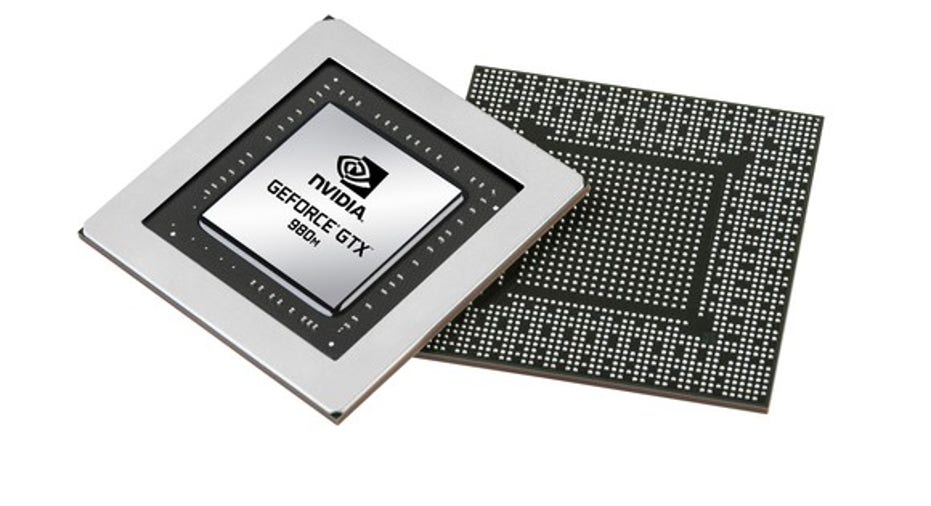Some Potential Good News for NVIDIA Corporation's Gaming Business

Image source: NVIDIA.
Back in May, graphics specialist NVIDIA (NASDAQ: NVDA) began launching new graphics processors targeted at gamers based on its new Pascal architecture. These new processors offered significant performance and power efficiency improvements over their predecessors based on the older Maxwell architecture.
If we look at each gaming-oriented graphics processor in the Maxwell family and then look at the corresponding Pascal replacement, we see that the company has increased pricing generation over generation by about $50.
During the Maxwell product cycle, NVIDIA's $329 GeForce GTX 970 was the company's best-selling product (according to numbers from the Steam Hardware Survey, anyway). Although it's still early on in the Pascal cycle, it would seem -- at least based on Amazon.com's (NASDAQ: AMZN) best-selling graphics card rankings (a single, but seemingly quite helpful data point) -- that the $379-plus GTX 1070 could be NVIDIA's best-selling product during the Pascal cycle.
Amazon's top 10 rankings
Amazon.com updates its best-selling graphics card list on an hourly basis, but as of a recent check, here were the top 10 sellers on the list:
Data source: Amazon.com.
Out of the top 10 sellers, two graphics cards are based on the GTX 1060, two are based on the GTX 1080, and four are based on the GTX 1070. Without knowing the absolute sales numbers for these cards, we can't say for certain if total GTX 1070 volumes are actually greater than total GTX 1060 volumes, but the fact that the GTX 1070 shows up twice as many times among the top 10 sellers is probably a good sign.
The GeForce GTX 1080 seems to be putting up a good showing here, too. Despite being significantly more expensive than the 1070 and the 1060, a 1080 card is the top seller -- at least as of this check of Amazon's rankings.
NVIDIA's average selling price story could continue
The revenue growth in NVIDIA's gaming-oriented graphics processor business has been driven by two factors: unit growth and average selling price (ASP) growth. It's hard to tell from this data point what kind of unit shipments NVIDIA is seeing relative to prior-generation products, but the data do seem to suggest that NVIDIA should see a nice boost in generation-over-generation ASPs.
Indeed, if NVIDIA simply sells as many GTX 1060, 1070, and 1080 cards as it did of the prior-generation 960, 970, and 980 cards, then by virtue of the ASP increases, the company should enjoy revenue and gross profit dollar growth.
If NVIDIA manages to see generation-over-generation unit growth on top of that (not a far-fetched notion), then that would serve to further catalyze the revenue growth story at the graphics specialist.
NVIDIA's most recent quarterly revenue guidance of $1.68 billion (at the midpoint of the range) represents approximately 29% revenue growth from the year-ago period. The generation-over-generationASP increases are at most 25% ($199 GeForce GTX 960 to $249 GeForce GTX 1060) with the increases narrowing with the 1070 relative to the 970 and the 1080 relative to the 980, so it would seem that NVIDIA's current revenue expectations bake in more than just ASP growth.
A secret billion-dollar stock opportunity The world's biggest tech company forgot to show you something, but a few Wall Street analysts and the Fool didn't miss a beat: There's a small company that's powering their brand-new gadgets and the coming revolution in technology. And we think its stock price has nearly unlimited room to run for early in-the-know investors! To be one of them, just click here.
Ashraf Eassa has no position in any stocks mentioned. The Motley Fool owns shares of and recommends Amazon.com and NVIDIA. Try any of our Foolish newsletter services free for 30 days. We Fools may not all hold the same opinions, but we all believe that considering a diverse range of insights makes us better investors. The Motley Fool has a disclosure policy.